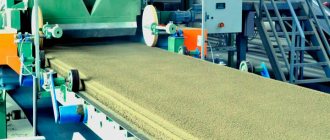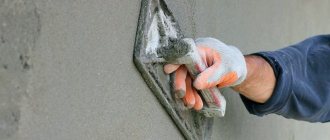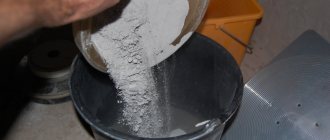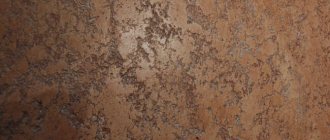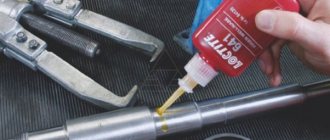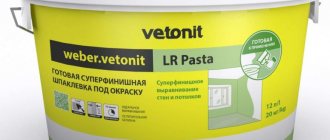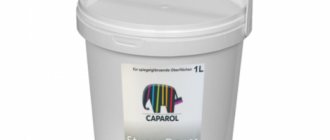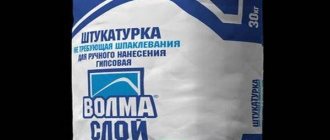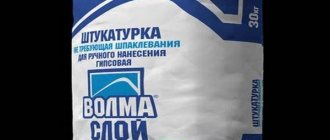Scope of application of Teplon plaster
Unis Teplon plaster is much lighter compared to other gypsum plasters.
In addition, Teplon gains strength faster compared to cement plasters. Its only drawback is its low moisture resistance: it can absorb moisture up to 400% of its own weight . That is why this kind of mixture is intended only for interior plastering work.
Teplon's enhanced water absorption has both positive and negative effects for builders
One of the advantages of the mixture is the high strength of the finished coating, due to its gypsum viscosity and low weight. Therefore, it is successfully used for:
- plastering the surface (wall and ceiling) without the use of reinforced mesh;
- preparation for painting;
- preparation for facing with expanded clay tiles;
- removal of small depressions up to 7 cm deep.
Like all gypsum plasters, Teplon creates a smooth, even and glossy surface even without additional putty.
Can be used for the following types of surfaces:
- wooden;
- brick;
- gypsum;
- gas and foam concrete.
All surfaces should be pre-treated with a primer before plastering.
At the last stage it is not necessary to use a plaster mesh. The consistency of the solution is homogeneous, light and characterized by rapid setting . All this adds up to significantly speed up construction work and increase productivity.
Scope of application.
The mixture is intended for internal use only.
Teplon levels the walls and ceilings of different rooms - residential and non-residential. This coating will later be suitable for wallpaper, paint or tiles. This is convenient because the teplon sets quickly and dries in a short time. You can reduce the hours spent on finishing work. Which leads to a reduction in the wage budget for craftsmen.
Thermal plaster is white and gray powders, used where humidity is within normal limits.
When the humidity is too high, using this composition is a bad option, since gypsum absorbs moisture well. There are other opinions on this matter.
Some specialists use Teplon plaster, a white powder with preliminary moisture insulation. Ceramic tiles are usually used as an insulator. If you carefully cover all the seams, the water will not reach the plaster. And unpleasant surprises can be avoided. Therefore, the coating is often found in bathrooms.
Main advantages
The advantages that Teplon plaster has are divided into several groups:
- good permeability for steam, which creates a healthy microclimate in the room; it becomes easy to breathe, which has a good effect on people’s condition;
- low thermal conductivity creates a heat-insulating layer, enhancing the heat-protective characteristics of wall ceilings and ceilings;
- environmental cleanliness; the mixture contains only natural and synthetic components that are not harmful to humans;
- profitability, reducing costs for finishing the premises;
- no shrinkage or cracking after drying; the coating is smooth and durable - if the technology for preparing the mixture, its application and drying conditions are followed;
- ease of application and leveling; there is no need to pre-reinforce the wall with mesh with a layer of up to fifty millimeters;
- the low weight of the Unis Teplon plaster reduces the load on the plane of the surface being finished;
- fast setting: finishing time is minimized;
- gloss after complete completion of work; if desired, white plaster can act as a finishing coating;
- there is no need to use finishing putties, which affects the additional benefit of using Teplon.
Specifications
Teplon as plaster has such technical characteristics that even a non-professional can easily handle it. The addition of perlite to the mixture determines a number of its special properties.
Compound
Unis teplon is a dry universal mixture based on gypsum. Additionally, the composition includes additives that ensure optimal mixing time and strength of the finished coating, crack resistance and a high level of adhesion of the solution to the surface.
One of the most popular mixtures on the construction market is Unis Teplon 30.
Strength
The strength of gypsum plasters is lower than that of cement plasters. The strength of Teplon is 2.5 MPa, i.e. 1 cm² can withstand a pressure of at least 25 kg without destruction. This is the standard strength level for all gypsum plasters . For comparison, the strength of its analogue - plasterboard - is slightly higher - 3 - 5 MPa. The adhesion strength is 0.1 MPa. This is also an average for mixtures intended for interior finishing work.
Layer thickness
The optimal layer thickness for the ceiling and wall is 0.5 cm, the maximum thickness for the wall is 5 cm and 3 cm for the ceiling . If it is necessary to make the layer thicker, plastering should be carried out in several stages. After waiting for the first layer to dry completely, you can proceed to applying the second.
To improve the adhesion of the next layer, it is recommended to apply notches or grooves using a spatula approximately 1 hour after the plaster has dried on the first layer.
Reinforcing mesh allows you to significantly increase the thickness of a single layer
Frost resistance
The frost resistance of the plaster mixture is 35 cycles , which means that it can withstand freezing and defrosting 35 times.
Colors
Unis is represented by two main types of gypsum plasters: gray and white Teplon. They differ not only in color, but also in technical characteristics. Therefore, before purchasing, it is advisable to read the instructions additionally.
More details about some of the differences in technical characteristics depending on color can be found in the table:
| Some technical characteristics of Teplon dry mixes | ||||
| Comparison criterion | Teplon | |||
| White | Grey | MN | Moisture resistant | |
| Color | white | grey | white | beige gray |
| Consumption at a layer thickness of 5 mm, kg/m2 | 4-5 | 4-4,5 | 6 | |
| Viability, min | 50 | 90 | 50 | |
In addition, the manufacturer allows for slight shade correlations depending on the gypsum used. The exact color will appear only after the surface has completely dried.
Thermal conductivity
Teplon has low thermal conductivity - 0.23 W/m oC , which provides thermal protection for the room.
This is achieved due to the modifying additive perlite included in the composition. It is believed that the lower this indicator, the higher the thermal insulation qualities of the building material.
Adhesion (stickiness)
The mixture is characterized by a high level of adhesion (adhesion of the solution), therefore the resulting coating is non-shrinking and crack-resistant. The coupling strength is 1.0 kgf/cm2 . Thanks to this, even without using a plaster mesh, you can increase the layer thickness to 0.7 cm.
Additional characteristics can be viewed in the table:
| Color | White gray |
| Temperature of work and operation | from +5 to +30°С |
| Amount of water per 1 kg of dry mixture | 0.45-0.55 l |
| Layer thickness without using plaster mesh | 5-50 mm |
| Consumption at a layer thickness of 5 mm | 4-4.5 kg/m² |
| Viability of solution | 50 minutes |
| Beginning of setting of the solution | no earlier than 50 minutes |
| End of setting of the solution | no later than 180 minutes |
| Drying time for a 10 mm thick layer | 5-7 days |
Moisture absorption
Thanks to the modifying additive perlite, high moisture absorption of the plaster is achieved, which should also be taken into account when choosing a mixture.
Consumption
Water consumption for Teplon is 4.5-5.5 liters per 10 kg . The viability of the solution is 50 minutes. This is a small indicator. For comparison, the viability of Rotband is 2 hours.
All gypsum plasters tend to set quickly, so the volume of the batch must be strictly combined with productivity
Characteristics
The natural components that make up Teplon do not cause allergic reactions and do not emit harmful substances. Thanks to the use of a special mineral called “perlite”, the plaster has increased heat-insulating properties. The material has a high degree of vapor permeability and does not allow liquid to remain inside, releasing water vapor through the pores to the outside.
TEPLON plaster is light in weight, the load on the treated surface is significantly lower than when using analogues. Thanks to this property, it is ideal for leveling ceilings and even balcony floors, where the weight of the finish plays a significant role.
The gypsum mixture easily copes with any defects on the surface. It is perfectly smoothed to a glossy shine, ideal for finishing materials that require a smooth surface without imperfections: paint or wallpaper, not to mention tiles. The composition should be applied indoors with a humidity level of no more than 75%.
If it is necessary to apply TEPLON plaster in a room with high humidity, then it is necessary to use tiles for cladding, and the seams between them must be thoroughly rubbed.
What to look for when purchasing
The material is distinguished by its ability to maintain a comfortable microclimate and normalize humidity levels thanks to its “breathable” and steam-permeable coating. Among its useful properties are heat conservation, noise absorption, and plasticity. Technical characteristics of Teplon plaster:
- it is allowed to apply the solution in a layer of 5-50 mm without using a reinforcing mesh;
- recommended temperature for repair work: +5 - +30 degrees;
- initial drying period: 50 - 60 minutes;
- final setting time : 3 hours;
- the diluted solution can be used for about 50-60 minutes;
- material consumption per 1 sq.m. area per layer thickness of 10 mm – 8.5 kg ;
- final strength gain (layer 10 mm thick, taking into account normal humidity levels) - 5 days - a week;
- thermal conductivity – 0.23 W/m*C;
- strength indicators: compression – from 25 MPa, adhesion to the surface – 0.1 MPa;
- the percentage ratio of water and plaster when mixing the solution is 0.5:1;
- Shelf life: 6-12 months.
Thanks to the above indicators, 1 square centimeter of plaster can withstand pressure from 25 kg without the threat of destruction, and the indicator of adhesion strength to the surface indicates good adhesion of the solution to the surface.
With a minimum permissible layer of mortar for walls or ceilings of 5 mm, the maximum thickness will be different - 50 and 30 mm, respectively, but within its limits you can do without reinforcement. Preliminary priming is mandatory.
Teplon gypsum plaster requires compliance with a temperature range from +5 to +30 degrees, which helps the solution gain strength and prevent shrinkage and cracking of the surface. The thicker the layer, the longer it takes to dry, and vice versa.
If there are large bulges or depressions, the maximum possible layer thickness is increased to 70 mm, but the solution is applied in several stages (25-30 cm each), allowing each layer to dry before applying the next one and treating it with a primer. After 50-60 minutes, it is recommended to make notches or grooves so that the second and third layers stick to each other better.
The viability of the finished mixture within one hour allows you to properly apply the solution to the surface and, if necessary, correct the work.
Places of application
Eunice Teplon White plaster is used to level ceiling surfaces and walls in rooms with moderate humidity.
| Area of use | Compatibility |
| For interior work | + |
| For outdoor use | — |
| Under a brick base | + |
| For concrete/reinforced concrete | + |
| Under foam concrete | + |
| Under old plaster | + |
| In dry rooms | + |
| In wet | Moisture resistant only |
| In unheated | Moisture resistant only |
| As decoration and plaster | — |
| Like texture wallpaper | + |
| For special institutions | + |
Suitable for almost any load-bearing surfaces, except bathrooms . The exception is a wall that is insulated from moisture. This can be achieved by laying tiles or ceramics over plaster. The seams should be carefully rubbed down. When in contact with any type of coating - brick, concrete, wood, it retains its useful qualities - plasticity, good adhesion and vapor permeability. The only condition is that the primer for each surface must be selected accordingly, and the whitewash must be removed before starting work with plaster, and only then can priming begin.
The main composition of Teplon White is gypsum. Additionally - special fillers - expanded perlite or glass hydroxide of volcanic origin. This allows for increased thermal insulation ability.
Features of application
Gypsum plaster is easy to use; you just need to figure out how to properly mix the solution, apply it to the surface and carry out the final stage of repair work - grouting and priming. Instructions for using the mixture include:
- removing previous coating from walls or ceilings, cleaning from oil stains and dirt;
- leveling the base, areas where chips and bulges are noticed;
- the need to wait two days after applying the solution to places where the coating was deformed;
- coating walls or ceilings with a primer in one or two layers before applying plaster;
- diluting the mixture with water at the rate of 0.45-0.55 liters for 1 kg , stirring for 2-3 minutes until the lumps completely disappear and the composition becomes homogeneous;
- when the mixture is infused - 5 minutes after mixing, it is mixed again;
- installation of beacons, metal guides with an interval of 1.2 m or more;
- applying the composition to the surface using the throwing method (allows you to increase the density of application) and recessing the beacons in it with mandatory orientation according to the level;
- removing excess mortar using the rule, without pressing the lath too much so that grooves do not form on the surface;
- 50-60 minutes after applying the mixture, the solution begins to fill the existing recesses;
- repeated removal of excess solution;
- smoothing and glossing (for wallpaper or painting);
- coating the surface with a primer after it has completely dried.
The mixture is exactly according to the rules.
The mixture for Teplon plaster is prepared quite simply. The main thing is to carefully study the manufacturer’s recommendations on the packaging of the dry mixture. And strictly follow what the instructions for use contain - then the composition will have the desired consistency and will adhere well to the surface.
It is important to accurately observe the proportions of water and dry powder, without deviating to the side. Standard ratio - 0.45; -0.55; liter of water per kilogram of mixture. For “Eunice Teplon” (white gypsum plaster) weighing 30 kg in a bag, you will therefore need 13.5-16.5 liters of clean water.
Expert advice: water should be in moderation; adding too much water will cause the solution to spread over the surface; if there is not enough water, the finished layer will begin to crack.
After the water and mixture are poured into the container, they need to be mixed thoroughly. It is better to use an electric mixer for this. Or take a drill and equip it with a special attachment.
Having mixed the components once, they are infused for 5-6 minutes. Then the Eunice Teplon plaster is mixed again.
And you need to start working right away. Due to the fact that the mixture contains gypsum, the plaster hardens very quickly. It must be applied to the surface within a maximum of fifty minutes. The best option is to do it in half an hour.
The remaining solution will have to be thrown away - it will not be possible to dilute it again, since the ingredients have already entered into a chemical reaction, and it has already completed. If you give in to the temptation and use the remaining mixture after the allotted fifty minutes, the coating will turn out to be very fragile - it will simply begin to crumble after a while. The technical characteristics of Teplon plaster no longer correspond to those stated.
Calculation of the required amount of mixture
The consumption of gypsum plaster before carrying out repair work can be calculated independently in order to protect yourself from wasting money and trying to deceive you.
Let's make a calculation for 10 sq.m of load-bearing surface:
- requirements – 5 cm ;
- the beacons are installed with deviations of 2, 4, 6 cm at three points - we add up these indicators and get 12, divide the sum by 3 (the number of beacons) - we get 4 - the average permissible thickness for one layer of plaster;
- look on the back of the package to see how much mixture will be used per 1 cm layer for 1 sq.m - this is approximately 8.5 kg;
- in order to find out how much plaster is needed for a layer 4 cm thick, multiply 4 by 8.5 (the number specified by the manufacturer), resulting in 34 kg for 1 sq.m of surface ;
- for a wall with an area of 10 sq.m, 340 kg of mixture will be required - this is 10 (area) multiplied by 34 (amount for 1 sq.m);
- Yunis Teplon gypsum plaster is produced in packages of 30 kg. Therefore, for 10 square meters of surface, 4 cm thick, you will need 11-12 packages of the mixture .
Now you know the technical characteristics of Teplon plaster, its advantages and disadvantages, application features, as well as a way to calculate the required amount of mixture - this is enough to competently prepare for the start of repair work and bring it to its logical end with benefit for you.
Consumption per square meter.
The price of “Eunice Teplon” (white gypsum plaster) weighing 30 kg in a bag is about three hundred to four hundred rubles. When the layer thickness is ten millimeters, Teplon plaster has a consumption of 8.5-10 kilograms per 1 m2. Accordingly, you will need to pay about one hundred to one hundred thirty rubles per m². The mixture is also sold packaged in fifteen kilogram bags.
The cost of applying such plaster is estimated differently. You will have to pay different amounts per square meter, depending on the qualifications of the craftsmen.
You can order the dry mixture on specialized websites. It will cost less per sq.m than buying it in a store.
Source
Overview of characteristics and properties
The main components of Teplon are gypsum, synthetic additives and filler. For the latter, perlite is used - expanded mica chips, which helps the plaster retain heat well. Due to limitations in the thickness of the applied layer and high price, the material is not considered as an independent heat insulator, but it enhances the thermal resistance of structures. The key technical characteristics of plaster include:
- The recommended temperature for application is within +5-30 °C.
- The permissible thickness of the layer not reinforced with mesh is 5-50 mm.
- Average consumption for a thickness of 5 mm is 4-4.5 kg/m2.
- The viability of the solution is at least 50 minutes, final hardening is 5-7 days.
- Strength: compressive strength – no less than 2.5 MPa, tensile strength – 0.3.
- Thermal conductivity coefficient -0.23 W/m °C.
Material consumption
The optimal scope of application for this UNIS series is leveling work; the required quantity largely depends on the curvature of the walls or ceilings. When applying a layer up to 10 mm thick, the plaster consumption per m2 does not exceed 10 kg, the average value is 8.5. User reviews confirm the value specified by the manufacturer; it is noted that the composition is distributed in a thin layer without problems and does not form shrinkage or cracks. According to the instructions, the material is not suitable for sealing cracks with a depth of more than 7 cm; the maximum permissible thickness when leveling ceiling structures is 30 mm.
Changing the proportions or introducing foreign substances is not allowed; in order to reduce the consumption of Teplon UNIS mixtures, preliminary preparation is carried out aimed at increasing adhesion (degreasing, dust removal) and filling large voids with other, more affordable compositions.
When working with large areas, it is advisable to buy options marked MN (machine applied). According to the manufacturer, their consumption is practically no different from conventional brands, but, according to reviews, it is slightly more than the specified 8 kg (but not higher than 10). Savings in this case are achieved by reducing labor costs. The maximum consumption is observed with a moisture-resistant non-shrinking variety - according to the instructions for use, it reaches 6.5 kg with a layer of up to 5 mm.
“I switched to plaster mixtures from Unis a long time ago; in terms of quality and characteristics they are not inferior to Rotband, but are cheaper. Almost all brands of this company are identical to each other and differ little, but in general they are convenient to use. I consider their good thermal conductivity, moisture resistance, good vapor permeability and strength to be a big advantage. For gluing thin wallpaper, I recommend gypsum plaster Eunice Teplon White, it does not need to be painted.”
Alexander, Tula.
“I am engaged in repairs and construction, I use the moisture-resistant Teplon plaster mixture for slopes and in bathrooms. Until now, I have not caused any complaints - no cracks, fits well and is quite elastic. I don’t recommend spreading Teplon in a thick layer; the composition slides along with the mesh, but with a thickness of 1-2 cm there are no problems at all. When working, you should take care of clean water in advance; a package of 30 kg will require at least 15 liters; all tools must be washed within an hour.”
Sergey, Voronezh.
“For me, the only difference between Rotband and Teplon is the price. Thermal insulation properties, hardening time and quality of adhesion are the same, they do not develop cracks, and both brands are easy to process. Perhaps, when compared after a long period of operation, the differences will manifest themselves, but I doubt it. According to reviews, Rotband is better in terms of strength, but I think that in reality it all depends on the application technology and operating conditions.”
Vladimir, Kursk.
“When renovating my house, I used heat-saving plaster Teplon Bely, laid it in 2 layers of 2 cm - a layer of 4 cm, according to the manufacturers, does not lie down - it begins to float. Both layers dried quickly and there were no cracks. The material is quite easy to level and process and does not require finishing putty. But I didn’t notice any significant energy saving effect.” “Previously I used only ordinary cement-sand plasters and gypsum putties, I decided to try ready-made leveling mixtures, and settled on Teplon - it’s easy to buy, all the stores are full of it. The material requires skill and getting used to; I didn’t get a straight wall right away. But then I decided to use it for applying small layers - it’s very easy to use.”
Material cost
| Name of the plaster brand UNIS | Recommended scope of application | Consumption per m2 with a layer thickness of 5 mm, kg | Weight of packing | Price, rubles |
| Teplon white | Interior decoration of walls and ceilings | 4-4,5 | 30 kg | 290 |
| Teplon gray | Leveling indoor surfaces before subsequent decorative finishing | 4 | ||
| Teplon moisture resistant | Crack-resistant composition for rooms with moderate and high humidity | 6-6,5 | 25 kg | 390 |
| Teplon MN | Mixture for machine application for complete or partial leveling of walls and ceilings in residential and public buildings | 4-4,5 | 30 kg | 325 |
Leveling differences of more than 50 mm
If the surface difference is more than 50 mm, it must be pre-leveled. To do this, the Yunis Teplon White plaster mixture is applied in several layers, each of which is laid with a plaster mesh. Instead of using a plaster mesh, it is allowed to apply cross-shaped notches with a comb or a notched trowel onto the plaster layer that has had time to set, but has not yet hardened (50–60 minutes after mixing).
The thickness of each layer should be no more than 30 mm. Before applying the next plaster layer, you should wait until the previous one has completely dried, and then treat the surface with Eunice primer. Installation of beacons at the preliminary alignment stage is not required.
Eunice Teplon is one of the highest quality plasters, which is characterized by durability, low cost and excellent performance characteristics. Using this mixture will allow you to significantly save on finishing work.
Plastering walls with Teplon
It is not allowed to add any components other than water to the dry mixture. Adding any components, including water, to a ready-made solution leads to a change in the properties of the material declared by the manufacturer.
To prepare the solution, use only clean containers and tools. Without waiting for the mixture to dry, press the beacons into the solution applied to the surface. The correct installation of the beacons is checked by level.
The distance between the beacons should be cm less than the length of the rule. Further work is carried out hours after the installation of the beacons.
The prepared solution is applied to the surface with a trowel or spatula within minutes after mixing, then leveled with a rule. The layer of applying the plaster mixture without using a plaster mesh on walls is from 5 to 50 mm and up to 70 mm when filling recesses, for ceilings - from 5 to 30 mm.
At the moment the solution begins to set, minutes after mixing the mixture, trim the applied layer using the rule, removing excess and filling the recesses. The resulting surface, after final drying, is suitable for gluing ceramic tiles. To do this, the plaster mixture is applied in several layers, each layer is laid with a plaster mesh. Installation of beacons for applying pre-leveling layers is not required. The thickness of each layer, if it is necessary to level out significant differences of more than 50 mm, should not exceed 30 mm.
Before applying a new layer of plaster mixture, you must wait until the previous layer has completely dried and treat the surface with UNIS primer. Depending on the thickness of the applied layer, minutes after trimming, moisten the surface with water, rub with a sponge trowel and smooth out the gypsum milk that appears on the surface using a spatula or trowel. The resulting surface, after drying, is suitable for wallpapering or painting.
Places of application
Certification in accordance with the legislation of the Russian Federation, including. The consumption of various mixtures depends on various factors, as well as on the conditions of use. The fact is that the specific gravity of the cement mixture is almost twice that of gypsum.
And now about the price. The price of gypsum plasters is almost 1.5 times higher than the price of cement mixture, which scares off uninformed buyers. As a result, gypsum plaster, which is not so cheap at first glance, turns out to be only slightly more economical than cement plaster.
Advantages and disadvantages
Gypsum plaster is not suitable for wet rooms, that is, only a cement mixture can be used in the bathroom. No amount of waterproofing will save plaster from spreading.
Tools and materials for work Gypsum plaster of the walls will ensure the breathability of the room and gradually bring the humidity level of the apartment in order. Composition of gypsum plaster: gypsum; fine filler; chemical additives. Advantages of gypsum plaster: Wall finishing without reinforcing mesh is allowed for a layer thickness of 5 to 50 mm; when filling recesses, the layer thickness can be increased to 70 mm.
A layer up to 30 mm thick can be applied to the ceiling. This is an environmentally friendly material with high vapor permeability and low thermal conductivity. If the application technology is followed, it does not shrink or crack. The finished solution is plastic, making it easier and faster to work with.
It is not necessary to putty the surface once it dries. Substrates on which you can work with gypsum plaster: Gypsum plaster can be applied to concrete, foam concrete, gypsum, cement-sand bases, brickwork, as well as to any other non-deformable bases.
Applying Gypsum Plaster As far as use is concerned, gypsum based plaster is easy to use. Photo 2 - Priming the walls after cleaning the surface from dust How to make a base for plaster work?
Before applying the plaster you need to wait at least 2 days. Photo 4 — We recess the beacon into the solution according to the level. How to dilute the mixture?
It is better to cover the floor with plastic film before starting plastering work. Photo 5 - Preparing a mixture for plastering walls. How long does it take for plaster to dry?
Features of application
How to properly plaster walls with your own hands? How to use a spatula?
Photo 6 - Throwing plaster onto the wall The formed depressions are filled with mortar 50 minutes after the start of applying the composition to the wall. It is technologically correct to apply no more than 30 mm of solution to ceilings.
Gypsum plaster Teplon
How to plaster a layer of more than 50 mm with gypsum plaster? How to use the rule? Photo 7 - Working as a rule Purpose of glossing and smoothing: why is this necessary? To do this, it is convenient to use a spatula or trowel. After this, you need to wait about a week until the composition completely hardens. Eunice Teplon is one of the highest quality plasters, which is characterized by durability, low cost and excellent performance characteristics.
Using this mixture will allow you to significantly save on finishing work. Advantages and disadvantages Modern gypsum plaster Eunice Teplon compares favorably with: Good vapor permeability, which creates a healthy microclimate in the room. Low thermal conductivity. A heat-insulating layer is created on the surface, which enhances the heat-protective characteristics of the premises.
The composition of Teplon gypsum plaster includes synthetic and natural components that cannot cause harm to health. No shrinkage or cracking.
Teplon White
Ease of application. Low weight, which significantly reduces the load on the plane of the treated surface. Fast setting.
No need to use finishing putty. The treated surface will be slightly glossy, so additional finishing may not be necessary. Composition of Teplon The main component of the mixture is gypsum, which acts as a binder. In addition to fine filler, synthetic additives are added to the mixture.
However, there are several differences: Yunis is a Russian manufacturer, and Knauf is a German company.
The cost of domestic putty will be approximately 60 rubles lower. Properties and cost of Teplon Before moving on to finishing work, it will be useful to familiarize yourself with the technical characteristics and properties of gypsum plaster: Strength is 2.5 MPa per 1 cm2.
In this case, the plaster can withstand pressure of more than 25 kg. By the way, the strength characteristics of the same drywall are not much more than MPa. The maximum layer thickness for ceilings is 3 cm, and for walls 5 cm. However, it is better to apply the plaster in a layer of about 0.7 cm. If you want to increase the thickness of the finishing material, you can use reinforcing mesh. Frost resistance - F The plaster is available in two colors - white and gray. It is worth considering that the white mixture may differ slightly from the gray composition in its properties, so before using it, be sure to read the instructions on the package.
Application of material
Unis Teplon plaster is applied using devices made of stainless steel. A wide spatula or trowel will do.
It is not necessary to use a mesh for plaster. Before starting work, construction beacons are placed. The first ones are installed at a distance of thirty centimeters from the corners, then every thirty centimeters - the rest. After this, slats are attached to the surface, for which alabaster is used.
The maximum layer of the mixture is fifty millimeters. For ceilings - no more than three centimeters. The consumption of Eunice Teplon plaster depends on what layer it will be applied.
In the process of applying the solution, it is important to ensure that it slightly covers the beacons. After the mixture is applied to the selected area, about an hour later, you need to remove excess solution using the rule. If depressions have formed, they are filled with plaster. After another half hour, the layer is moistened and treated with a grater with a spongy structure.
When the solution is completely dry, you can apply the next one, if necessary. But first the surface must be primed. This is done if the surface being treated has a height difference of more than fifty millimeters, the plane must be leveled. To do this, apply several layers of the mixture, strengthening each with a reinforcing mesh.
Expert advice: if you are working with such a composition for the first time, it is better to use the rule, the length of which is about one and a half meters. At the same time, it is reasonable to set its width to one meter twenty to one meter thirty centimeters.
The result is a smooth matte surface. After it has completely dried, you can glue wallpaper onto it. It is believed that the mixture dries completely after seven days. Moreover, the mixture should be applied at a temperature of (+5; +30) degrees Celsius. It is important for it to dry at the same temperature. Then there will be no cracks, and there is no need to worry about shrinkage.
If you want to decorate the wall with tiles, the surface should be glossed. The Yunis Teplon plaster is glossed using a Venetian trowel. The movement is performed in the form of a cross.
Ceiling nuances
Yunis Teplon gypsum plaster (white color) is applied to the ceiling with some specific nuances. The process proceeds in the same way as when working with walls, but the maximum layer of mortar is allowed no more than three centimeters. It is also important to very accurately monitor the evenness of the coating: on the ceiling, the slightest irregularities are especially noticeable. Using such a solution for finishing ceilings allows you to:
- improve thermal insulation;
- reduce the load on the entire structure by using fairly lightweight material;
- carry out the work very quickly and easily;
- get a durable layer.
Grounds for confidence.
Unis Teplon plaster is applied to surfaces made of materials:
According to experts, it adheres equally well to all these materials. The main thing is to properly prepare the surface using the appropriate primer solution. If the wall or ceiling was previously covered with lime, it must be completely removed and washed off. Otherwise, even the use of a primer will not give the desired result - and the Unis Teplon plaster will not adhere to the base firmly enough.
An important point: it is not recommended to plaster wooden surfaces with Teplon. Wood does not adhere well to plaster.
The car comes to the rescue
An important advantage of using Eunice Teplon plaster is that it can be applied using a special machine. To do this, you need to purchase a mixture intended specifically for machine application. It is a little more expensive than the composition that is used for manual work.
Gypsum plaster "Unis (unis) Teplon" in a thirty-kilogram bag will cost about seven to eight dollars. The consumption of Unis Teplon plaster in the machine version will be slightly different from how much mixture is spent when applied manually. However, in the end, the costs are justified by reducing the time required to arrange the plaster layer.
